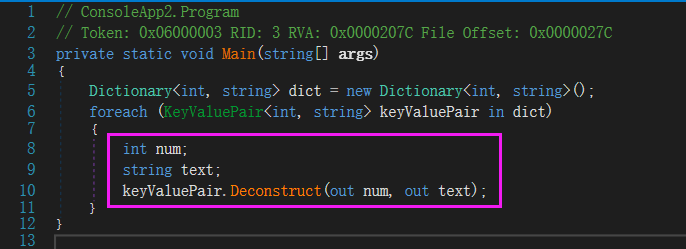一:背景
1. 讲故事
前几天在写一个api接口,需要对衣物表进行分页查询,查询的output需要返回两个信息,一个是 totalCount,一个是 clothesList,在以前我可能需要封装一个 PagedClothes 类,如下代码:
public class PagedClothes
{
public int TotalCount { get; set; }
public List<Clothes> ClothesList { get; set; }
}
static PagedClothes GetPageList()
{
return new PagedClothes()
{
TotalCount = 100,
ClothesList = new List<Clothes>() { }
};
}
在 C# 7.0 之后如果觉得封装一个类太麻烦或者没这个必要,可以用快餐写法,如下代码:
static (int, List<Clothes>) GetPageList()
{
return (10, new List<Clothes>() { });
}
这里的 (int, List<Clothes>) 是什么意思呢? 懂的朋友看到 (x,y) 马上就会想到它是 .NET 引入的一个新类:ValueTuple,接下来的问题就是真的是ValueTuple吗? 用ILSpy 看看 IL 代码:
.method private hidebysig static
valuetype [System.Runtime]System.ValueTuple`2<int32, class [System.Collections]System.Collections.Generic.List`1<class ConsoleApp2.Clothes>> GetPageList () cil managed
{
IL_0000: nop
IL_0001: ldc.i4.s 10
IL_0003: newobj instance void class [System.Collections]System.Collections.Generic.List`1<class ConsoleApp2.Clothes>::.ctor()
IL_0008: newobj instance void valuetype [System.Runtime]System.ValueTuple`2<int32, class [System.Collections]System.Collections.Generic.List`1<class ConsoleApp2.Clothes>>::.ctor(!0, !1)
IL_000d: stloc.0
IL_000e: br.s IL_0010
IL_0010: ldloc.0
IL_0011: ret
} // end of method Program::GetPageList
从 GetPageList 方法的 IL 代码可以很容易的看出方法返回值和return处都有 System.ValueTuple 标记,从此以后你可能就会以为 (x,y) 就是 ValueTuple 的化身 ,是吧,问题就出现在这里,这个经验靠谱吗?
二:(x,y) 真的是 ValueTuple 的化身吗
为了去验证这个经验是否靠谱,我需要举几个例子:
1. (x,y) 接收方法返回值时是 ValueTuple 吗
为了更加清楚的表述,先上代码:
(int totalCount, List<Clothes> orders) = GetPageList();
static (int, List<Clothes>) GetPageList()
{
return (10, new List<Clothes>() { });
}
现在已经知道当 (x,y) 作为方法返回值的时候在IL层面会被化作 ValueTuple,那 (x,y) 作为接受返回值的时候又是什么意思呢? 还会和 ValueTuple 有关系吗? 为了去验证,可以用反编译能力弱点的 dnspy 去看看反编译后的代码:

从图中可以看出,当用 (x,y) 模式接收的时候,貌似就是实现映射赋值 或者 叫做拆解赋值,是不是有一点模糊,这个 (x,y) 貌似和 ValueTuple 有关系,又貌似和 ValueTuple 没关系,不过没关系,继续看下一个例子。
2. (x,y) 在 foreach 迭代中是 ValueTuple 吗
(x,y) 也可以出现在 foreach 中,相信第一次看到这么玩还是有一点吃惊的,如下代码:
var dict = new Dictionary<int, string>();
foreach ((int k, string v) in dict)
{
}
接下来继续用 dnspy 反编译一下:

我去,这回就清晰了,从图中可以看出,我写的 (x,y) 压根就没有 ValueTuple 的影子,说明在这个场景下两者并没有任何关系,也就是说同样是 (x,y) ,放在不同位置具有不同的表现形式,这就很让人琢磨不透了, 可能有些朋友不死心,想看一下 Deconstruct 到底干了什么,知道的朋友应该明白这个新玩法叫做解构方法,继续看代码:
public readonly struct KeyValuePair<TKey, TValue>
{
private readonly TKey key;
private readonly TValue value;
public void Deconstruct(out TKey key, out TValue value)
{
key = Key;
value = Value;
}
}
有些抬杠的朋友会发现一个规律,貌似 (x,y) 放在赋值语句的左边都和 ValueTuple 没有任何关系,放在右边可能会有奇迹发生,那到底是不是这样呢? 继续硬着头皮举例子呗。
3. (x,y) 放在赋值语句的右边是 ValueTuple 吗
public class Point
{
public int X { get; set; }
public int Y { get; set; }
public Point(int x, int y)
{
(X, Y) = (x, y);
}
}
嘿嘿,看这句: (X, Y) = (x, y) 里的 (x,y) 是 ValueTuple 的化身吗? 我猜你肯定是懵逼状态,是吧,亦真亦假,虚虚实实,证据还是继续反编译看呗。

我去,又是和 ValueTuple 一点关系都没有,啥玩意嘛,乱七八糟的,莫名其妙。
三: 总结
说 (x,y) 是元组吧,放在 return 中就变成了 ValueTuple ,说 (x,y) 不是元组吧,放在其他处还真就不是的,是不是很疑惑,为了更加形象,在 Point 中再增加一个 Test 方法,对照一下源码和反编译的代码:
//原始的:
public class Point
{
public int X { get; set; }
public int Y { get; set; }
public Point(int x, int y)
{
(X, Y) = (x, y);
}
public (int x, int y) Test()
{
return (X, Y);
}
}
//反编译的:
public class Point
{
public int X { get; set; }
public int Y { get; set; }
public Point(int x, int y)
{
this.X = x;
this.Y = y;
}
[return: TupleElementNames(new string[]
{
"x",
"y"
})]
public ValueTuple<int, int> Test()
{
return new ValueTuple<int, int>(this.X, this.Y);
}
}
反正我已经恼火了,就这样吧,少用经验推理,多用工具挖一挖,这样才靠谱!
如您有更多问题与我互动,扫描下方进来吧~
